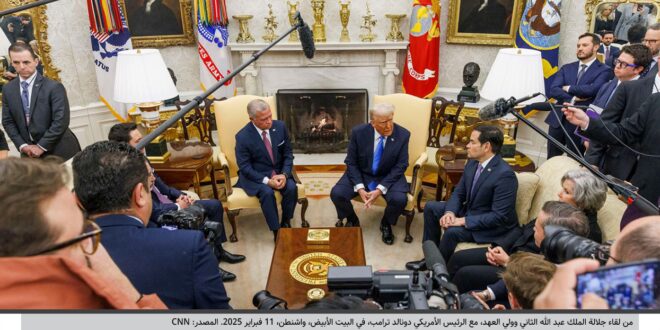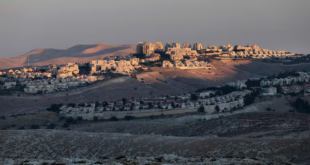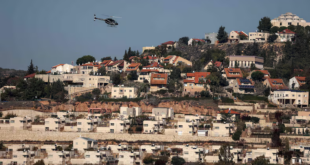Jordan has previous experience in dealing with US President Donald Trump, during his first administration, which showed his tendency to liquidate the Palestinian cause, regardless of considering the constants of the Palestinian cause and the principles of US foreign policy towards it. Given the difficult changing reality that the Gaza Strip, the Middle East and the international community are going through, the Jordanian position is based on calculations that seem more accurate this time compared to what they were in the wake of the first Trump administration, especially since the threat today includes all Palestinian territories, and is not limited to the Gaza Strip.
His Majesty King Abdullah II bin Al Hussein met with US President Donald Trump at the White House in Washington, DC, on February 11, 2024, as part of a working visit he has been making to the United States since February 9, during which he met with US National Security Advisor Mike Waltz, and US Special Envoy to the Middle East Stephen Witkoff, in addition to members of committees in the US House of Representatives and Senate. This visit comes within the context of Jordanian diplomatic efforts to reject the US President’s position on the day after the war in the Gaza Strip and the Palestinian issue, and to determine the seriousness of his calls to displace the people of the Strip, and its connection to Jordanian-Arab coordination regarding the future of the Strip, as it is the first visit by an Arab leader, and comes after Israeli Prime Minister Netanyahu met with him on February 4.
The American-Israeli discourse on displacement
Calls and plans to displace the people of the Gaza Strip have appeared since the outbreak of the war on October 7, 2023, and they came primarily from the extreme right-wing parties in the Israeli government, considering displacement a radical solution to achieve security in Israel, and an opportunity to re-settle Israeli settlement in the Strip. However, this discourse was not officially and approved by the political or military levels, and was not specified more explicitly in the Israeli plans for the day after the war. Although the military campaign directly targeted health and educational facilities and worked to destroy the foundations of life in the Gaza Strip, it was read as part of a plan to make life in the Strip impossible and create an uninhabitable geography. However, displacement remained an unlikely option until US President Donald Trump revived it, and even adopted it as an American plan, which he revealed with the entry into force of the ceasefire agreement on January 19, 2025, and then his inauguration on January 20, which is based on transferring a large part of the people of the Strip to Egypt, Jordan, Indonesia, Albania and other countries, and he confirmed this during his meeting with Israeli Prime Minister Benjamin Netanyahu on February 4.
However, it is possible to note the continuous changes in President Donald Trump’s discourse regarding the motives for displacement. The first proposal was for displacement for the purposes of reconstruction, which was understood at the time to be a temporary measure. However, in his interview with the American Fox News Channel on February 9, he stated that he would not allow the displaced to return, and that he was talking about building a permanent place for them outside the Strip. Then the talk moved to the United States owning the Strip in exchange for a sum of money, before moving towards imposing authority on the Gaza Strip under American authority without clarifying the form and legitimacy of that authority. This inconsistency shows that displacement is still an idea for the American administration and the Israeli government that is not yet mature in terms of tools and features.
However, the US President starts his speech based on the reconstruction paper, which has always been considered one of the most complex files on the day after the war, specifically regarding the unsuitability of the Strip for its residents, as the Strip suffers from massive destruction of infrastructure, services and housing, as UN estimates indicate that more than 90% of the Strip’s homes have been destroyed, and that the war has left more than 50 million tons of rubble/which may take 21 years to remove, and that rebuilding destroyed homes may continue until 2040, in addition to the collapse that has affected all economic activities, and according to the International Labor Organization, the unemployment rate has risen to 80% and nearly 100% of the population now lives in poverty. In addition to Washington’s desire to empty the Strip in order to completely eliminate the underground tunnel network of the factions and Hamas.
Sensitivity of the Jordanian position
Jordan has previous experience in dealing with US President Donald Trump, during his first administration (2016-2020), which showed his tendency to liquidate the Palestinian issue, regardless of considering the constants of that issue and the principles of US foreign policy towards it, and the demands and calls of Arab countries, especially neighboring countries (Jordan and Egypt). At that time, Trump presented his plan to resolve the Israeli-Palestinian conflict, which he called “Peace to Prosperity” and was known in the media as the “Deal of the Century”. His proposal for the plan came about a week after his victory in the 2016 elections. Later, he recognized Jerusalem as the capital of Israel in December 2017, thereby bypassing UN General Assembly Resolution No. (181) in November 1947, which stipulated the internationalization of Jerusalem to protect religious interests in the city. Then, in May 2018, he moved the US embassy from Tel Aviv to Jerusalem. Then, in August, he decided to stop economic aid allocated to the West Bank and Gaza Strip, estimated at more than $200 million, and transfer it to other places. Then, in September 2018, his administration announced the closure of the Palestine Liberation Organization office in Washington. In March 2019, he recognized Israeli sovereignty over the Golan Heights, which has been occupied since 1967. In the same year, Trump supported an Israeli plan to annex the Jordan Valley, prompting His Majesty to warn in an interview with the German newspaper Der Spiegel of a “major clash” if Israel annexed parts of the West Bank.
In fact, the “Deal of the Century” did not succeed, nor did Israel’s plans to annex the Jordan Valley. The King and Jordanian diplomacy played a role in preventing either of them from being achieved, especially through multilateral work with Arab, Islamic and European countries. After the events of October 7 and the war in Gaza, Jordan warned against Israel’s attempts to exploit military operations and American support to change facts on the ground, and considered the displacement from the West Bank a “declaration of war.” All of this was preceded by organizing an international and UN conference on the humanitarian response in the Gaza Strip on June 11, 2024 , with the participation of Egypt and the United Nations, and with the attendance of representatives of 75 countries, in addition to international humanitarian and relief organizations. According to those present, the outcomes of that conference constitute the basic structure for future planning for the reconstruction of the Strip.
However, the current scene seems more complex. In practical terms, it does not seem that the American president or Israel have a clear plan for the displacement process. However, the seriousness of these calls stems from the complexities of the reality in the Gaza Strip, the Middle East, and the international community.
On the one hand, the Middle East is entering a new phase of reorganizing its powers and balances, especially in light of the repercussions of the war in the Gaza Strip, and the transformations in Syria, the possibility of chaos in which will have disastrous consequences for the region, as well as the polarization between the countries of the region regarding the position on reconstruction. Internationally, the Chinese and Russian positions have represented a reluctance to intervene in the Israeli-Palestinian conflict, not exceeding the positions calling for an end to the war, while European countries are preoccupied with the Russian-Ukrainian war, and their fears of American pressure on them regarding accepting a settlement for the war in Ukraine may not take into account the calculations of European countries. However, the Atlantic bloc also seems to be harmed by President Trump’s orientations at the geographical level, especially after his calls to annex Canada and Greenland, which is affiliated with Denmark, to American territory. This means that its rejection of calls for displacement in the Gaza Strip under American authority, as Trump mentioned, is an integral part of its rejection of the annexation of Canada and Greenland, in addition to Europe’s desire to play a secure and logistical role in the Gaza Strip in the future.
Reading in His Majesty’s statements
Given the changing and difficult reality that the Gaza Strip and the Middle East, and more generally in the international community, are going through, the Jordanian position is based on calculations that seem more precise, complex and intertwined this time compared to what they were in the wake of the first Trump administration, especially since the threat today includes all Palestinian territories, and is not limited to the Gaza Strip, in light of the existence of an Israeli plan that seeks to annex the settlements in areas classified as (C) to its sovereignty, and has been carrying out a large-scale military operation there since January 21, 2025, which has forced about 20,000 Palestinians to leave their homes, and estimates indicate that about 90% of the residents of Jenin camp have left it.
On the other hand, the current circumstances require multilateral action, especially by Arab and Islamic countries, to support the Jordanian position. His Majesty’s visit to Washington was to closely explore Trump’s position and assess the seriousness of his calls for displacement, especially since it came days after Prime Minister Benjamin Netanyahu’s visit. While Trump was supposed to discuss broader issues, as is customary in the King’s meetings with American presidents, especially the Syrian issue, in which Jordan plays a pivotal role, the press conference revealed the centrality of the next day in the Gaza Strip in the two leaders’ conversation.
Meanwhile, His Majesty the King’s responses and statements were diplomatic, to prevent a clash at the wrong time, given the general state of the Middle East, the need for joint Arab action, and to avoid Jordan being subjected to economic or political pressures similar to what it was subjected to when the Deal of the Century was proposed, especially since President Trump’s first executive orders were to temporarily suspend US foreign aid to all countries except Israel and Egypt.
Therefore, His Majesty’s statements and comments carried several implications, as follows:
First: A letter addressed to American institutions
During his conversation with President Trump, His Majesty the King maintained diplomatic discourse towards the United States. This discourse was directed to American institutions that have strong relations with Jordan, and in order to spare the Palestinian issue and the Jordanian position from President Trump’s improvised discourse. Therefore, His Majesty the King stressed the pivotal role of the United States in the region, and reaffirmed it in a tweet he published after the meeting ended.
Second: Exit for exceptional humanitarian cases
His Majesty the King stated that Jordan is ready to receive about 2,000 children from the Gaza Strip who suffer from chronic diseases. This is a clear message that Jordan is ready to receive specific categories of the people of the Strip according to specific and causal cases. This reception is temporary and urgent, given Gaza’s lack of a health sector capable of treating these people, and will end once Gaza is reconstructed and its medical sector is rehabilitated.
Third: Presenting an alternative Arab plan
His Majesty the King avoided engaging in controversial responses to Trump’s ideas that were not transferred to the practical and objective side, preferring to present a practical alternative by referring to an “alternative plan” that Egypt will present. The Egyptian Foreign Ministry announced after the meeting that Egypt intends to present a comprehensive vision for the reconstruction of Gaza. His Majesty the King and Egyptian President Abdel Fattah el-Sisi also confirmed during a phone call on February 12, 2025, the “unity of the Egyptian and Jordanian positions,” especially regarding the start of the reconstruction process. Thus, the two countries present a solution that ends the arguments on which Trump’s speech is based regarding the unfitness of the sector for habitation, and that the Arab response to Trump’s plan will be a parallel plan for reconstruction that takes into account humanitarian affairs and the continued presence of Palestinian citizens in Gaza.
Fourth: Emphasis on multilateral action
During the meeting with President Trump, His Majesty the King sought not to speak solely of Jordanian considerations, given the seriousness of the issue at hand and its repercussions on the region, but rather emphasized joint Arab action. Therefore, His Majesty stated that “the Arabs will come to America with a response to Trump’s plan regarding Gaza,” which is expected to be issued by a plan that Egypt is working on, and which is likely to receive Arab consensus at the emergency Arab summit that will be held on February 27 in Cairo, while the regular Arab summit that was scheduled to be held in Baghdad has been postponed.
Fifth: The interests of the Palestinians and Arabs into consideration
His Majesty stressed the need for plans to be suitable for all parties, saying: “We have to consider how to implement this in a way that serves the interests of all,” meaning that solutions must suit everyone, including the people of the Gaza Strip, Jordan, Egypt and the rest of the Arab countries, and not in a way that serves the interests and ambitions of the extreme right in Israel, or the current ideas of President Donald Trump.
Sixth: Jordanian interest first
In response to a question about whether Jordan would provide a plot of land where Palestinians could live, His Majesty the King said: “I have to do what is in the interest of my country.” In fact, Jordan has a long experience in settling refugees on its territory, the most recent of which was the Zaatari camp for Syrian refugees, which was established on a plot of land above the Amman-Zarqa water basin. However, there is an awareness of the repercussions of this and its consequences, especially at the level of infrastructure, services and resources, in addition to fears of repeating the displacement scenario in the West Bank, which means trying to pass the goals of settlement and liquidate the Palestinian cause at Jordan’s expense.
Seventh: Not to compromise on Jordanian constants
His Majesty stressed the Kingdom of Jordan’s rejection of attempts to resolve the Palestinian issue by displacing the Palestinian people from their land. He added in a post on the “X” platform following the meeting: “I reiterated Jordan’s firm position against the displacement of Palestinians in Gaza and the West Bank. This is the unified Arab position.” He added that “a just peace based on the two-state solution is the only way to achieve stability in the region, and this requires the leadership role of the United States,” indicating that the “two-state solution” is the Arab-accepted proposal.
Eighth: The search for just and sustainable peace
His Majesty the King stressed that “there is a way to bring peace and prosperity to the region,” and that this will not be achieved in practice without reaching a just solution to the Palestinian issue, and he refutes the idea of displacement, which will have repercussions and repercussions that will extend across the Middle East. His Majesty the King indicated that “everyone’s priority is to rebuild Gaza without displacing its people, and to deal with the difficult humanitarian situation in the Strip,” and it does not seem that there is another way to achieve real peace.
Jordanian alternatives to confront displacement
The displacement plans being circulated by US President Donald Trump and the Israeli government do not seem to be capable of being transformed into a practical plan with a specific time frame. The royal responses and comments were aware of these facts, and maintained a balance that prevents the displacement discourse from being placed at the present time in an objective position. This can be considered a first step in joint Arab and Islamic steps that will work to present a more objective and applicable alternative, based on the reconstruction of the Gaza Strip, and achieving peace that is consistent with everyone’s aspirations.
The results of the visit came quickly in changing the American tone towards displacement. First, Trump sent a message to the Jordanian people, praising His Majesty the King and the Jordanians. Later, White House spokeswoman Caroline Levitt explained that Washington is waiting for the Arab peace proposal, and that Trump is committed to the vision of peace in the Middle East.
In fact, the current Jordanian position is considered a step in an ongoing context of work to reject displacement, and here a set of alternatives can be suggested as follows:
1- Supporting and consolidating the comprehensive Arab position that rejects displacement operations, and working to prevent Arab divisions over other issues from affecting the unified position against displacement and supporting the reconstruction process.
2- Reviewing the peace agreement signed with Israel, legally and internationally, and including the clauses through which evidence can be presented that it is against the displacement process.
3- A real explanation, in the language of numbers and expectations, of the state of instability in the region, and the increase in uncertainty, especially towards Israel.
4- Forced displacement may exacerbate new conflicts and disputes in the region, and may create unexpected crises.
 Eurasia Press & News
Eurasia Press & News



